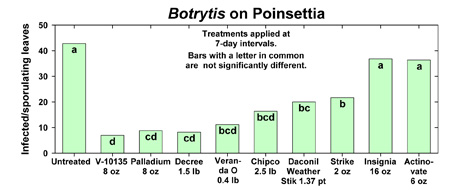Botrytis blight update
Editor’s note: This article is from the archives of the MSU Crop Advisory Team Alerts. Check the label of any pesticide referenced to ensure your use is included.
Stem, leaf, and flower blights caused by the fungus, Botrytis cinerea, can limit all phases of ornamental production. Botrytis is well known for its ability to produce large masses of gray conidia that may be picked up and carried on air currents and transported to healthy plants where blight can become established. Monitoring the occurrence and build-up of this inoculum in the greenhouse can signal the need for implementing control measures. On bedding and stock plants, Botrytis typically becomes established and produces spores on aging lower leaves that are near the moist soil surface and under the plant canopy. In addition, Botrytis readily infects the broken or cut stem surface of stock plants and progresses downward, causing a dieback of the entire stem.
Fungicides are often important in managing Botrytis and should be chosen carefully. Geraniums are good test plants because they seem to be a “magnet” for this disease. All fungicides are applied and allowed to dry prior to introducing Botrytis spores. Each time a test is conducted, fungicides that are considered especially effective are included for a comparison. Over the years of testing fungicides for Botrytis control, Decree, Chipco 26 GT, and fungicides containing chlorothalonil (Daconil and Echo) have been used as standards because they consistently provide effective control.
Evaluation of fungicides for control of Botrytis blight of poinsettia
In a research greenhouse on the campus of MSU, 60 poinsettias of uniform size were selected and placed in individual humidity chambers. Treatments were replicated six times in a completely randomized design with a single plant per replicate. Plants were watered as needed. Treatments were applied to runoff using a pressurized air sprayer on December 3 and 10. Botrytis cinerea cultures were grown on potato dextrose agar for four weeks. Plates were flooded with sterile distilled water and scraped with a sterile spatula to dislodge spores. Liquid from the plates was strained through cheesecloth, and diluted to 5 x 106 conidia/fl oz. Botrytis cinerea inoculum was applied to runoff after treatments had dried using a handheld mister on December 3 and 10. Infected leaves, sporulating leaves, disease severity and amount of residue were recorded on December 10 and 18.

Figure 1. Disease pressure was severe in this trial with the untreated plants
receiving a rating of 8.3 (10=plant death) by the end of the trial. All treatments
with the exception of Actinovate and Insignia significantly reduced infected
leaves and disease severity by the final rating date. On December 18, plants
treated with the experimental fungicide V-10135 had significantly fewer
infected leaves and less overall disease severity than the untreated control
and all other treatments except Decree 50WDG, Palladium 62.5WG (not
yet registered), Endorse 11.3DF, and Chipco 26019 50WDG. Similar results
were seen for number of leaves with pathogen sporulation. Spray residue was
evaluated for all of the treatments. Of the products shown to be effective in
this trial, those with the least residue included Palladium 62.5WG and Endorse
11.3DF.
Dr. Hausbeck's work is funded in part by MSU's AgBioResearch.



 Print
Print Email
Email




